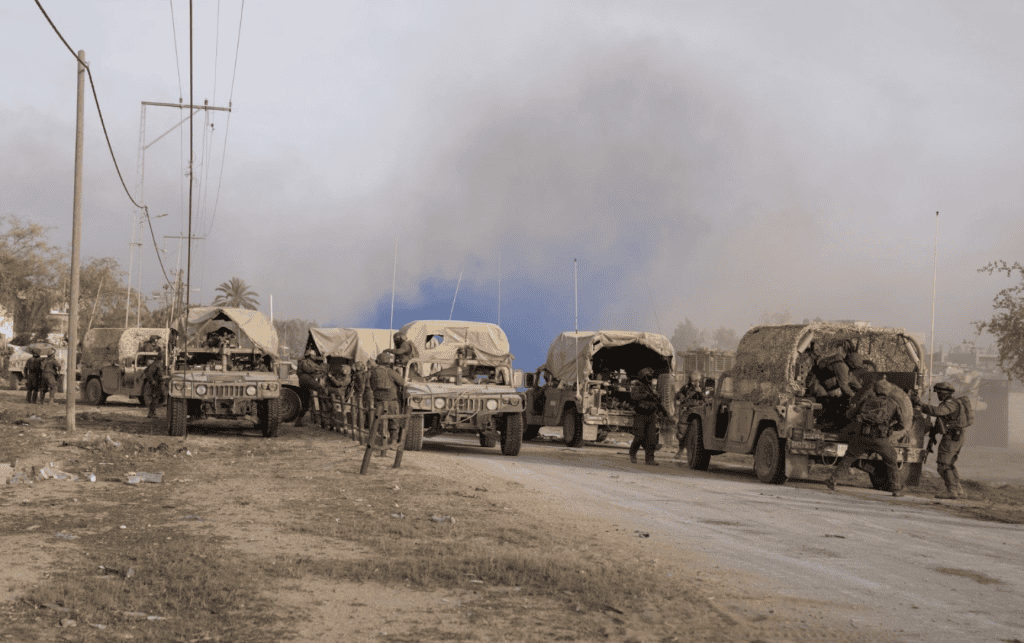
Three weeks after launching an offensive along the border of southern Gaza and Egypt, the Israel Defense Forces achieved “operational control” of the Philadelphi Corridor. This is the name of the border area of southern Gaza that stretches from Israel to the Mediterranean Sea. Part of the area includes Rafah while its eastern and western ends are mostly rural areas. The operational control means the IDF can now spend weeks or months dismantling tunnels and other terrorist infrastructure along the border. Israel’s National Security Advisor Tazhi HaNegbi said on May 29 the war in Gaza could last another seven months.
The border area is 7.5 miles long. It has long been a center of weapons smuggling that has fueled Hamas and other terror groups in Gaza. The IDF last took control of this area in an operation in 2003 when it also dismantled terrorist infrastructure in Rafah and along the border, before leaving Gaza completely in 2005. Since January, when the IDF began to wrap up operations in northern Gaza, Rafah has been in the crosshairs of Israel’s military and political establishment. The IDF chose to concentrate on northern Gaza first in a ground maneuver in late October and November. In December it shifted focus to Khan Younis, the city near Rafah that is the hometown of Hamas leader Yahya Sinwar. After a pause in operation in April, the IDF chose May for the Rafah offensive.
IDF spokesperson Rear Admiral Daniel Hagari called the Philadelphi Corridor the “lifeline” of Hamas on May 29 in a statement to media. The IDF is now seeking to find and uproot tunnels that may be along the border with Egypt. The 162nd division is leading this effort. It is the same unit that led IDF operations throughout northern Gaza from October until April and therefore has extensive experience in dismantling Hamas infrastructure. However, as subsequent operations have shown in places like Jabalya, the initial operations have required the IDF to often return to root out more tunnels and weapons used by the terrorists.
Israeli forces have found dozens of rocket launchers in the area along the Egyptian border. In some cases, Hamas located these systems within 100 feet of the border to make it harder for Israel to respond. 20 tunnels have been found in the area so far. The IDF may be slowly releasing information about the tunnels due to the sensitive nature of the discoveries. Egypt has long denied that tunnels continue to be operational for smuggling between Egypt and Gaza.
One tunnel found by the IDF was a mile long and located near the Rafah border crossing between Egypt and Gaza. This crossing was seized by IDF tanks on May 7 and Egypt closed the border. On May 25 the Egyptians agreed to re-route aid to Gaza via Israel’s Kerem Shalom crossing. Hamas has targeted that border crossing at least four times in May. The tunnel found near the Rafah crossing included “large quantities of weapons, including anti-tank missiles, AK-47s, explosives and grenades,” the IDF said.
The IDF continues to suffer casualties in fighting in Gaza. Three soldiers were killed on May 28 in a booby-trapped building in Rafah and another soldier was killed on May 29. This brings the total losses for the IDF to 294 over seven months of ground maneuver in Gaza and other fronts. Overall, 642 soldiers have been killed since the Hamas attack on October 7, with many of the fallen killed on October 7 itself.
The IDF has wrapped up most of its operations in Jabalya in northern Gaza after several weeks of fighting there. The bodies of hostages were recovered from the area. The IDF continues to control the Netzarim Corridor across central Gaza, using a reserve armored brigade and reserve infantry brigade to conduct sweeps in the area and secure the corridor. This means the IDF now controls two corridors across Gaza. The Netzarim Corridor is where the US-built temporary pier was affixed in mid-May on the Mediterranean side. However, the pier was damaged by waves on May 25 and is being repaired.
Hamas has claimed numerous attacks in the Gaza Strip between May 26 and May 29. These include sniper fire as well as use of 60mm mortars, 107mm rockets and what Hamas refers to as the Yasin 105 anti-tank munition. The shift in Hamas tactics after the initial shock of the IDF advances in various areas reflects a decision by it and other terror groups to move to sniping attacks and the use of booby-traps in buildings. Hamas statements reported by pro-Iranian media illustrate that the group is coordinating and communicating with other terror groups across Gaza, such as Palestinian Islamic Jihad and other groups.







